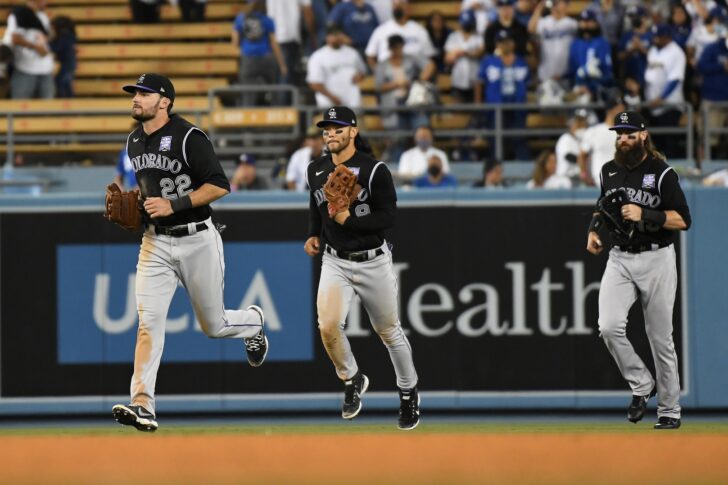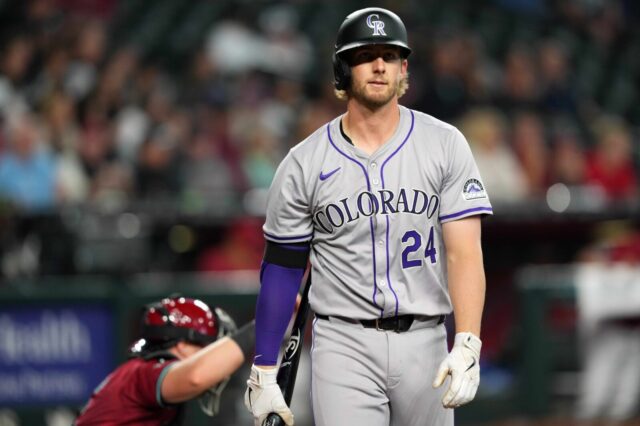The Colorado Rockies’ outfield can best be described by using a common phrase:
Quantity over quality.
The unit certainly isn’t bad, but there’s not a single difference maker in the bunch. Some have been that in the past, and maybe one or two of the players has a chance to be that in the future. But at the moment, the outfield is composed of a bunch of guys who are basically lost in the shuffle.
Colorado’s outfielders finished in the bottom third in baseball in both rWAR and fWAR. There were worse groups in the league, sure, but not many were as all over the place as the Rockies in terms of distribution of playing time. Six outfielders had 200 or more plate appearances for the Rox in 2021, and inconsitency–more than injury–was the reason. Of those six players, only two–Charlie Blackmon and Connor Joe–finsihed the season worth more than a win above replacement level. Then again, only two were below replacement, and they combined for just 47 plate appearances, but on the whole it was a mediocre group full of of half-win players.
Most Valuable and Biggest Surprise: Connor Joe (1.6 rWAR, 1.4 fWAR)
Joe was solid in the field, providing the Rockies with 6 Defensive Runs Saved in left field and in limited time at first base, but his real value came with the bat. Joe entered the season on some darkhorse contributor lists as a result of a strong minor league résumé that eventually landed him with the division rival San Francisco Giants and nearly earned him a spot on a World Series-contending Los Angeles Dodgers team in 2019, and he didn’t disappoint. The 29-year-old, one-time first round draft pick hit .285/.379/.469–about 17 percent better than league average–while giving the Rockies the kind of quality at-bats they’ve rarely had over the last few seasons.
Consider this: Joe’s 12.3 percent walk rate was the highest posted by any Rockies outfielder with 200 or more plate appearances since Dexter Fowler in 2013. And Joe in 2021 was a much better overall hitter than Fowler was that season. But, perhaps that’s what we should’ve expected from a guy who has beaten all the odds–including cancer–on his way to becoming a big league regular, which is what Joe should be when the Rockies begin the 2022 season.
Least valuable: Yonathan Daza (0.4 rWAR, 0.5 fWAR)
Daza was not a bad baseball player in 2021. He played good defense in center field and, for a large part of the season, was hitting over .300 at the plate. The problem, though, is he provides little impact offensively outside of a batting average that is entirely dependent on batted ball luck due to his lack of power. When Daza entered play on June 20 hitting .331, he did so on the strength of a .410 batting average on balls in play. From that day through the rest of the season, though, Daza’s average sunk to .208, and that’s because his BABIP fell to .250.
A good defensive outfielder with nice speed and decent contact skills is does not make up the worst player the Rockies could run out there. But, again, it’s the lack of true impact talent that gets the Rockies–in particular, their outfield group–in trouble, and Daza is almost the poster boy for that.
Biggest disappointment: Raimel Tapia (1.0 rWAR, 0.4 fWAR)
Tapia seemed destined for another step forward after posting a .321/.369/.402 line in his first real opportunity as an everyday player in 2020. Unfortunately, he proceeded to hit the ball on the ground at a higher rate than any qualified major league hitter in the last 20 years. Almost 70 percent of the balls Tapia put into play were grounders, an issue that is exacerbated by the Rockies’ home park, which rewards fly-ball contact more than any other venue in the league. If Tapia still had the elite sprint speed he displayed upon debuting in the big leagues almost a half-decade ago, that would be one thing. But he’s merely a good runner–134th-fastest in the league, according to Statcast–these days, making his batted ball profile really stink.
What happens next?
Garrett Hampson remains a riddle wrapped in an enigma. He flat-out could not hit away from Coors Field, but he certainly wasn’t alone in that regard. He is one of the fastest players in the game, and his defense has taken a leap in the right direction. He could stand to walk more at the plate, but he also rarely makes soft contact. It feels like there’s still something there with Hampson, but he’s running out of chances to prove it. Sam Hilliard, meanwhile, wasn’t as good defensively as Hampson, but he came on strong after rejoining the big league club following a long stint in Triple-A. He found himself demoted in early May after a .108/.154/.324 start that included a near 50 percent strikeout rate, but after being called back up at the conclusion of the All-Star break, Hilliard managed to cut his strikeout rate by a third and slugged nearly .500 in almost 200 plate appearances.
Either of those players could start 2022 as the Rockies’ centerfielder, and both will likely get a chance to stick if the other falters. But both players are flawed, not having exactly blown the doors off during their respective stints in the majors. The Rockies will also have to figure out how to best handle Charlie Blackmon, whose production is dipping with each year that passes but will still probably end up as the starting right fielder for as long as he wants to be. Major help is on the way a few years from now, when Zac Veen–a .301/.399/.501 hitter in his debut season as a pro and a darkhorse top 10 overall prospect heading into next season–inevitably joins the Rockies. But until then, defense-first and contact-heavy–but not necessarily high-impact–options such as Ryan Vilade and Jameson Hannah represent the team’s best hopes in terms of in-house outfield candidates.
The good news is there should be plenty of help available on the free-agent market. The bad news, of course, is the Rockies are extremely unlikely to choose that route. Should they surprise almost everyone and spend some money on available outfielders, though, the likes of Kyle Schwarber, Joc Pederson, Chris Taylor, Jorge Soler, and Michael Conforto would all fit well to varying degrees in Colorado. The more realistic option, though, would have the Rockies searching the scrap heap. That’s where old friend Michael Tauchman resides, along with the likes of Franchy Cordero, Delino DeShields, Billy Hamilton, and others.



